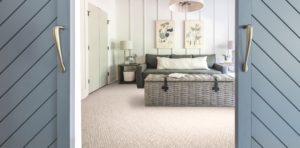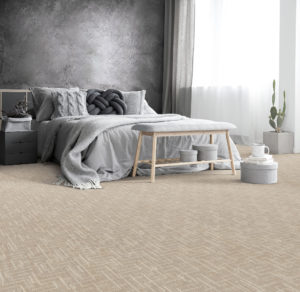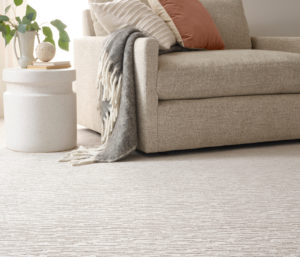Just as COVID-19 helped usher in a period of prosperity for the residential carpet industry that spanned nearly two years, the flip side is that observers feared the pandemic-induced rally would eventually run its course for carpet. It appears that time has arrived as those heady double-digit gains have been supplanted by losses, at least on the residential side of the business.
Year-to-date, encompassing the first and second quarters, residential sales are down 3.4% versus the year-ago period, according to industry estimates; Q2 residential sales, meanwhile, are down 5.4%. What’s more, unit volume decreased 10.3% through the first two quarters compared to 2021; and Q2 square yards declined by 10.4%, evidenced by the slowdown at retail.
To put things into context, 2021 stood out as an aberration as residential carpet sales grew 17.2%. More than perhaps any other category, carpet benefited by the events triggered by COVID-19—work-from-home/school-from-home that led to more rooms using carpet to achieve quieter conditions in the household.
However, now that COVID-19 restrictions have been lifted, carpet no longer enjoys that advantage, observers said. Furthermore, the industry is now dealing with the cumulative effect of inflationary pressures and raw material price increases.
“The trend is not positive,” said T.M. Nuckols, president of The Dixie Group’s residential division, in referencing the 3.4% decline in residential carpet sales and 10.3% drop in volume at the halfway point of 2022. “We do not have industry numbers for Q3 yet, but I do not expect any improvement.”
Nuckols said many factors are contributing to this negative tilt, including inflation, rising interest rates, stock market volatility, increased vacation travel and even the upcoming mid-term elections. “They are all having a negative impact on the residential business this year,” he explained. “Compared to 2021 and early 2022, momentum has already slowed significantly. It will take some time to see inflation come down, so I think we will continue to see challenging conditions for the short term.”
What hasn’t stopped are price increases—up to eight in the last 18 months. Consequently, the average selling price (ASP) for carpet has risen 11.6% YTD compared to 2021 and was 10.9% higher in Q2.
The good news is the commercial segment has improved significantly. After 20-plus percentage declines in sales and volume in 2020, commercial finished 2021 up 2.8% in sales and flat in square feet. The upward trajectory continued in 2022; year-to-date commercial sales are up 16% vs. 2021 while units are ahead 7.2%. In Q2, commercial sales increased 2.4% and units rose 7.6%, research shows.

Executives define the high-end/better goods segment as products priced at $20 per square yard wholesale—and as high as $50 to $60 for luxury soft surface broadloom.
The main middle, still a major area of focus for mills, is generally priced at $9 to $16 per square yard (wholesale), with $12-$13 the median. Commodity wholesale is often priced at $6-$8 per square yard wholesale.
Typically, during challenging economic times, the high-end/luxury end-use segment remains cushioned from fluctuations in the economy. That is proving true again this time. “The upper end is more insulated, and we’ve seen that insulation around affluent buyers,” said Herb Upton, vice president of product development-residential, Shaw Industries.
Don Karlin, director of broadloom sales for Nourison, added that while the upward pressure on costs is still present, “it appears that the consumer expects [increases] and buys what she wants. The impending economic decline is due to the Fed raising interest rates, not because people have decided to stop buying things. Additionally, most people are employed with a steady income. If someone wants flooring, they will most likely buy it.”
The annual inflation rate for the U.S. was 8.3% for the 12 months ended August 2022 after rising 8.5% previously, according to U.S. Labor Department data published Sept. 13. In fact, inflation has been above 5% for 12 consecutive months, peaking in June 2022 at just over 9%. A year ago, the U.S. inflation rate was 5.25%; in August 2020 it was 1.3%.
Understandably, mill executives are worried that out-of- control inflation will have dire consequences on the psyche of American consumers.
Jamie Welborn, vice president of product management, soft surface, Mohawk, echoed a familiar refrain when he said he was “very concerned” with the state of inflation. “When consumers have to pay more for necessities such as food and gas, it will absolutely impact remodeling,” he explained. Other executives agreed. “It’s a natural concern as the cost-of-living increases, consumers will continue to scrutinize their discretionary spending more than ever,” said Mike Sanderson, vice president of marketing for Engineered Floors. “Flooring might not be considered as high of a priority in comparison to, say, a family vacation.”
Chet Graham, president of Marquis Industries/Gulistan, acknowledged that while inflation will continue to reduce everyone’s discretionary spending, there is a glimmer of good news on the horizon. “We are starting to see a flattening in raw materials, which should help slow this market influence,” Graham explained. “As housing start-ups slow, consumers will make decisions to stay in their residences longer and will be starting home improvement projects. Carpet continues to be one of the least expensive upgrades.”
Shaw’s Upton noted that while inflation has contributed to a slowdown in retail traffic, he believes in the entrepreneurial spirit of independent retailers. “I love the tenacity of specialty retailers. Their ability to be creative will win the day.”

The Dixie Group’s Masland Pedigree is new for 2022. “It is a pattern with a beautiful linen-like visual,” Nuckols said. “For a pattern, it has a heavy face weight, so it has a very nice, comfortable feel. And it’s made with our EnVisionSD Pet Solutions nylon, so it delivers the best in durability and stain performance.”
Fabrica Ithaca is a new, eye-catching Colorpoint pattern. Made with EnVision Nylon, Ithaca presents an impressive abstract pattern, Fabrica color line and visual interest.
Engineered Floors’ most recent DW Select introduction, Manuscript, features a high-contrast, geometric pattern that leverages the company’s PureColor Solution-Dyed PET twistX technology. This color enhanced MLCL (Multi-Level Cut Loop) pattern uses the latest tufting technology to create a visual suitable for bedrooms, living rooms and entertainment spaces.
Mohawk’s Modern Story I, II and III is a good/better/ best collection of EverStrand polyester featuring a tight and clean construction with a great color line. Among the many new styles for Karastan is Artful Radiance, which is crafted of Kashmere nylon and provides an interesting texture created in part with ColorMax technology.

Pet Perfect and Pet Perfect+ carpets feature Shaw’s Anso high-performance fibers (in nylon and PET), in addition to stain/soil protection and bleach/fade resistance. Pet Perfect+ carpets from A/T and Shaw Floors come with LifeGuard spill-proof technology.
Stanton’s Tattersall II by Crescent has added five new colors as part of its fall launch. Featuring 100% New Zealand wool, Tattersall II by Crescent, a division of Stanton, offers striking color combinations in a traditional tailored plaid design. Tattersall II can be used in a wall-to-wall installation, custom-sized area rug, stair or hallway runner.
Name: Ken Wong
Mobile:+86 13621900645
Tel:+86 13621900645
Email:[email protected]
Whatsapp:+8613621900645
Add:Building IV-J,B Area, No.925 Yecheng Road,Jiading Industral Zone,Shanghai